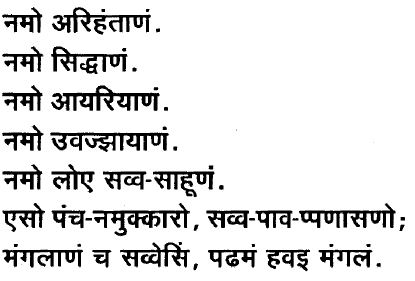Navkār Mantra
Navkār Mantra is eternal and there is no creator or composer of it. It is the quintessence of all Jain prayers. It is noteworthy that Navkār Mantra is not found in any early scriptures. The practice of writing Navkār Mantra at the beginning of any scriptures could have started after around 1st century AD. The manuscripts of Kalpasutra which was written around 450 AD are seen with Navkār Mantra at the beginning of the main texts.
There were two inscriptions found on the rocks:
In Kharvel (present Orissa) – Namo Arihantanam, Namo Savva Siddhanam
In Mathura – Namo Arihantanam, Namo Siddhanam (This one is thought to have been carved in 6th century AD)
In an incident in the life of Pārshvanāth Bhagwān, he recites the Navkār Mantra to a pair of snakes who were about to die after accidentally being burnt in fire. This attests that Navkār Mantra was in existence during 9th century BC.
There are many other conflicting evidences with regard to the origin and history of Navkār Mantra, but it is possible that the Navkar Mantra in its present form did not exist during the time of Mahavir Swami. People used to bow down to pay respects to enlightened and liberated souls without actually saying the exact phrases. The present form may be composed by unknown writer or writers who may have been disciples of the Tirthankars.
This is the first and foremost prayer for the Jains. It is indeed the first prayer Jain children are taught. The basis of this prayers is Namaskara (नमस्कर) which means:
– to give salutation to
– pay homage to
– give obeisance to or worship
– bow down to
Namas (नमस्) which means salutation, obeisance, adoration, bowing, paying homage to is the essence of this great payer. The first five verses begins with giving obeisance to each of the five parmesthis and also ends with paying homage to them. Only those who are humble and modest would pay homage to someone else who has better qualities than themselves. Humility appears, as ego and arrogance disappears. It manifests into devotion when the head/mind, two hands and two legs all result in prostrating the object of devotion. This is called Pañcāṅga (पञ्चाङ्ग) Namaskara.
What is important to bear in mind is that obeisance is not given to the Panch Parmesthis because of their superiority, but because we are praying to be endowed with their qualities and virtues.
It is not explicitly mentioned in the Agams, but Navkār is the essence of all the scriptures and therefore it is called Mahāmantra.
There are 9 Pada (designations), 8 Sampadā (which means attainment / success /accomplishment / good fortune) and 68 letters in Shree Navkār Mantra. In these sixty eight letters there are 7 guru-jodākshar (measuring two matras /conjunct consonant) and 61 laghu (small letters).
Click here to read more about the Navkār Mantra in Brāhmi script.


Namo Arihantāṇam
Namo Siddhāṇam
Namo Āyariyāṇam
Namo Uvajjhāyāṇam
Namo Loe Savva-Sāhuṇam
Eso Panch Namukkāro
Savva Pāva-ppaṇāsaṇo
Mangalāṇam Ca Savvesim
Padhamam Havai Mangalam
My obeisance to:
– Arihant Bhagwants
– Siddha Bhagwants
– Acharya Bhagwants
– Upadhyaya Bhagwants
– All Sadhu Bhagwants in the entire Universe
Obeisance to these five annihilates all sins. This obeisance is the most auspicious of all that is auspicious.
References:
1. Prabodh Tika by Param Pujya Panyas BhadrankarVijayji Maharaj & Param Pujya Munishree Kalyanprabhavijayji Maharaj
2. Internet
3.Navkar Mantra Ma Sampada by R C Shah
4. Wisdomlib
I apologise and seek pardon for any unintentional errors in translation of the verses.